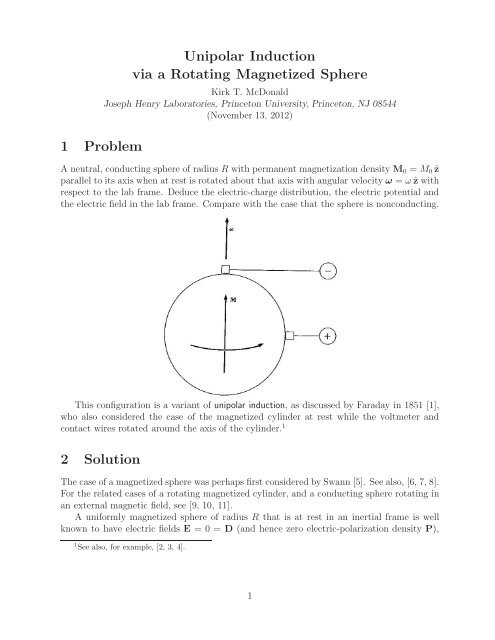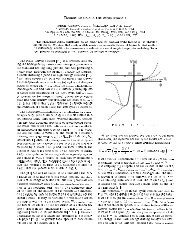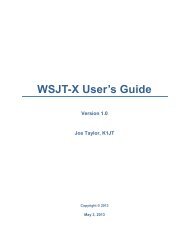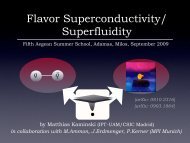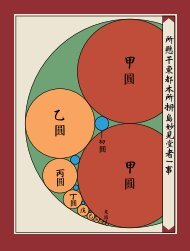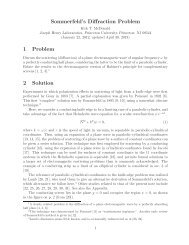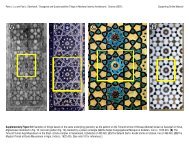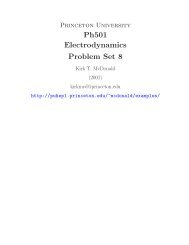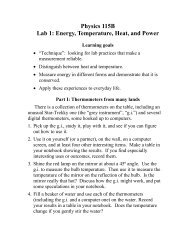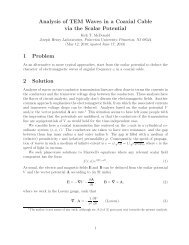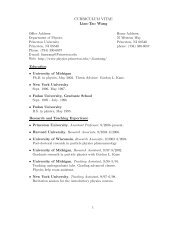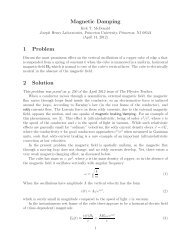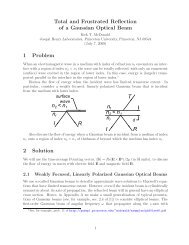Unipolar Induction via a Rotating Magnetized Sphere - Princeton ...
Unipolar Induction via a Rotating Magnetized Sphere - Princeton ...
Unipolar Induction via a Rotating Magnetized Sphere - Princeton ...
You also want an ePaper? Increase the reach of your titles
YUMPU automatically turns print PDFs into web optimized ePapers that Google loves.
1 Problem<br />
<strong>Unipolar</strong> <strong>Induction</strong><br />
<strong>via</strong> a <strong>Rotating</strong> <strong>Magnetized</strong> <strong>Sphere</strong><br />
Kirk T. McDonald<br />
Joseph Henry Laboratories, <strong>Princeton</strong> University, <strong>Princeton</strong>, NJ 08544<br />
(November 13, 2012)<br />
A neutral, conducting sphere of radius R with permanent magnetization density M 0 = M 0 ẑ<br />
parallel to its axis when at rest is rotated about that axis with angular velocity ω = ω ẑ with<br />
respect to the lab frame. Deduce the electric-charge distribution, the electric potential and<br />
the electric field in the lab frame. Compare with the case that the sphere is nonconducting.<br />
This configuration is a variant of unipolar induction, as discussed by Faraday in 1851 [1],<br />
who also considered the case of the magnetized cylinder at rest while the voltmeter and<br />
contact wires rotated around the axis of the cylinder. 1<br />
2 Solution<br />
The case of a magnetized sphere was perhaps first considered by Swann [5]. See also, [6, 7, 8].<br />
For the related cases of a rotating magnetized cylinder, and a conducting sphere rotating in<br />
an external magnetic field, see [9, 10, 11].<br />
A uniformly magnetized sphere of radius R that is at rest in an inertial frame is well<br />
known to have electric fields E =0=D (and hence zero electric-polarization density P),<br />
1 See also, for example, [2, 3, 4].<br />
1
while the magnetic fields are given (in Gaussian units) by<br />
B(r >R)=H(r >R)= 3(m 0 · ˆr)ˆr − m 0<br />
,<br />
r 3 B(r
Likewise, there is a bound surface-charge density,<br />
σ bound (r = R) =P(R − ) · ˆr = ωRM 0 sin 2 θ<br />
, (8)<br />
c<br />
where θ is the polar angle with respect to the z-axis. The total bound charge is zero,<br />
∫<br />
Q bound =<br />
∫<br />
ρ bound dVol+<br />
2.1 Nonconducting <strong>Sphere</strong><br />
∫<br />
σ bound dArea = − 8πR3 ωM 0<br />
+ 2πR3 ωM 1 0<br />
(1−cos 2 θ) d cos θ =0.<br />
3c c −1<br />
(9)<br />
If the sphere is nonconducting there are no free charges or currents.<br />
The electric field E can be deduced from a scalar potential V ,<br />
E = −∇V = −∇V ρ − ∇V σ , (10)<br />
where the potential V ρ (continuous at r = R) due to the bound volume-charge density (7) is<br />
V ρ (rR)=− 8πR3 ωM 0<br />
, (11)<br />
3c<br />
3cr<br />
and the potential V σ (also continuous at r = R, andwhichobeys∇ 2 V σ = 0 except at r = R)<br />
due to the bound surface-charge density (8) can be written in the form<br />
V σ (rR)= ∑ n<br />
where P n is the Legendre polynomial of order n. Notingthat<br />
P 0 =1, and P 2 = 3cos2 θ − 1<br />
2<br />
A n<br />
R n+1<br />
r n+1 P n(cos θ), (12)<br />
=1− 3sin2 θ<br />
2<br />
the bound surface-charge density (8) is related to the potential V σ by<br />
σ bound = ωRM 0 sin 2 θ<br />
= 2ωRM 0<br />
c<br />
3c<br />
= E σ,r(R + ) − E σ,r (R − )<br />
4π<br />
(P 0 − P 2 )<br />
( ∂Vσ (R − )<br />
= 1<br />
4π<br />
∂r<br />
− ∂V σ(R + )<br />
)<br />
∂r<br />
, (13)<br />
= ∑ (2n +1) A n<br />
n 4πR P n. (14)<br />
Hence, the Fourier coefficients A n are all zero except that<br />
Thus,<br />
V σ (rR)= 8πωM 0<br />
3c<br />
3<br />
. (15)<br />
( )<br />
R<br />
3<br />
r − R5<br />
5r P 3 2<br />
. (16)
and the total electric potential is<br />
V (r R)=− 4πR5 ωM 0<br />
(3 cos 2 θ − 1).<br />
5c<br />
15cr 3 (17)<br />
The difference ΔV in potential between points on the equator and on the “north” pole of<br />
the sphere is<br />
ΔV = V (θ =90 ◦ ) − V (θ =0)= 4πR2 ωM 0<br />
. (18)<br />
5c<br />
Note also that inside the sphere, V (r R), while inside it 3<br />
D r (r
electric field E are the same as for a conducting sphere, with zero magnetization, that rotates<br />
in a uniform, external magnetic field [11].<br />
The free charges inside the sphere must be at rest relative to the rotating sphere. That<br />
is, the electric field in the comoving frame must be zero at points inside the sphere; E ⋆ =<br />
0=E + v/c × B, recalling eq. (3), so the lab-frame electric field for rR)=− 8πR5 ωM 0<br />
P<br />
3cr 4 2 (cos θ), E θ (r>R)=− 4πR5 ωM 0<br />
sin 2θ. (29)<br />
3cr 4<br />
The difference ΔV in potential between points on the equator and on the “north” pole of<br />
the sphere is<br />
ΔV = V (θ =90 ◦ ) − V (θ =0)= 4πR2 ωM 0<br />
, (30)<br />
3c<br />
which is slightly larger that the result (18) for a nonconducting sphere. Of course, a rotating<br />
nonconducting sphere could not be used as a unipolar generator.<br />
5
For completeness, we note that the surface-charge density is given by<br />
σ total = E r(R + ) − E r (R − )<br />
4π<br />
= 8πRωM 0<br />
[2 − 5P 2 (cos θ)], (31)<br />
9c<br />
of which the bound surface charge is given by eq. (8). Finally, the electric-displacement field<br />
D inside the conducting, magnetized sphere is<br />
2.3 Comments<br />
D(r
[7] L. Davis, Stellar Electromagnetic Fields, Phys.Rev.47, 632 (1947),<br />
http://puhep1.princeton.edu/~mcdonald/examples/EM/davis_pr_72_632_47.pdf<br />
[8] A.I. Miller, <strong>Unipolar</strong> <strong>Induction</strong>: A Case Study in the Interaction between Science and<br />
Technology, Ann. Sci. 38, 155 (1981),<br />
http://puhep1.princeton.edu/~mcdonald/examples/EM/miller_as_38_155_81.pdf<br />
[9] K.T. McDonald, <strong>Unipolar</strong> <strong>Induction</strong> <strong>via</strong> a <strong>Rotating</strong> <strong>Magnetized</strong> Cylinder (Aug. 17,<br />
2008), http://puhep1.princeton.edu/~mcdonald/examples/magcylinder.pdf<br />
[10] J.J. Thomson, Recent Researches in Electricity and Magnetism (Clarendon Press, 1893),<br />
secs. 434-440,<br />
http://puhep1.princeton.edu/~mcdonald/examples/EM/thomson_recent_researches_sec_434-440.pdf<br />
[11] K.T. McDonald, Conducting <strong>Sphere</strong> That Rotates in a Uniform Magnetic Field (Mar.<br />
13, 2002), http://puhep1.princeton.edu/~mcdonald/examples/rotatingsphere.pdf<br />
[12] J.D. Jackson, Classical Electrodynamics, 2nd ed. (Wiley, New York, 1975), sec. 5.10.<br />
[13] H. Minkowski, Die Grundgleichen für die elektromagnetischen Vorlage in bewegten<br />
Körpern, Göttinger Nachricthen, pp. 55-116 (1908),<br />
http://puhep1.princeton.edu/~mcdonald/examples/EM/minkowski_ngwg_53_08.pdf<br />
http://puhep1.princeton.edu/~mcdonald/examples/EM/minkowski_ngwg_53_08_english.pdf<br />
[14] J. van Bladel, Relativistic Theory of <strong>Rotating</strong> Disks, Proc. IEEE 61, 260 (1973),<br />
http://puhep1.princeton.edu/~mcdonald/examples/EM/vanbladel_pieee_61_260_73.pdf<br />
[15] T. Shiozawa, Phenomenological and Electron-Theoretical Study of the Electrodynamics<br />
of <strong>Rotating</strong> Systems, Proc. IEEE 61, 1694 (1973),<br />
http://puhep1.princeton.edu/~mcdonald/examples/EM/shiozawa_pieee_61_1694_73.pdf<br />
[16] K.T. McDonald, Electrodynamics of <strong>Rotating</strong> Systems (Aug. 6, 2008),<br />
http://puhep1.princeton.edu/~mcdonald/examples/rotatingEM.pdf<br />
[17] H.A. Lorentz, Alte und Neue Fragen der Physik, Phys.Z.11, 1234 (1910),<br />
http://puhep1.princeton.edu/~mcdonald/examples/EM/lorentz_pz_11_1234_10.pdf<br />
[18] V. Hnizdo and K.T. McDonald, Fields and Moments of a Moving Electric Dipole (Nov.<br />
29, 2011), http://puhep1.princeton.edu/~mcdonald/examples/movingdipole.pdf<br />
[19] S.J. Barnett, Magnetization by Rotation, Phys.Rev.6, 239 (1915),<br />
http://puhep1.princeton.edu/~mcdonald/examples/EM/barnett_pr_6_239_15.pdf<br />
7


